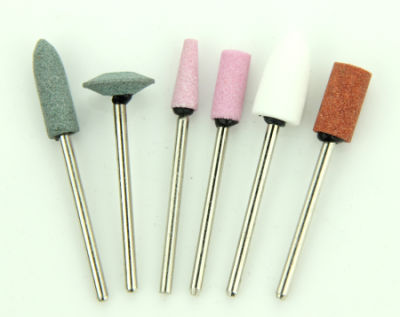Dental burs and abrasives are essential tools in dentistry, used for shaping, smoothing, and polishing various dental materials. One of the most popular types of dental burs are mounted stones, including green stones, pink stones, and white stones. These mounted stones are abrasive instruments that are used to shape and polish dental restorations, including ceramic, metal, and composite materials.
Green Stones
Green stones are made from high-quality diamond particles and are typically used for contouring and shaping ceramic restorations. They are highly effective at shaping and smoothing the material, making them the best choice for contouring and finishing ceramic restorations. The specific shape and grit size of the bur will depend on the type of restoration and the desired outcome.

Pink Stones
Pink stones are made from aluminum oxide and are used for contouring and finishing metal restorations. They are particularly effective at removing excess metal and smoothing the surface of the restoration. The specific shape and grit size of the bur will depend on the type of metal being worked on and the desired outcome.

White Stones
White stones, on the other hand, are made from silicon carbide and are used for contouring and finishing composite restorations. They are particularly effective at smoothing and polishing composite materials, which can be more difficult to work with than ceramics or metals. The specific shape and grit size of the bur will depend on the type of composite material being worked on and the desired outcome.

Factors to Consider when Choosing Mounted Stones
Dental professionals should choose the appropriate bur for each procedure based on the material being worked on and the desired outcome. Choosing the right HP stone for a specific dental procedure will depend on several factors, including the type of material being worked on, the desired outcome, and the shape and size of the bur. Dental professionals should consult with the manufacturer's guidelines and their own experience to determine the best bur for each procedure.
While each type of bur is designed for a specific purpose, they can often be used for multiple procedures. For example, a green stone may be used to contour both ceramic and composite restorations, while a pink stone may be used for both metal and ceramic restorations. However, using a bur on the wrong material can cause damage or reduce its effectiveness.

The Correct Method for Cleaning and Disinfecting Mounted Stones
Proper cleaning and sterilization of mounted stones is essential to ensure patient safety and prevent the spread of infection. After each use, the bur should be cleaned using a bur brush and a cleaning solution to remove any debris or residue. The bur should then be sterilized using an autoclave or other sterilization method approved by the manufacturer.
Potential Risks and Side Effects of Mounted Stones
As with any dental procedure or tool, there are potential risks and side effects associated with the use of mounted stones. These can include damage to teeth or restorations, sensitivity, pain or discomfort, bleeding or swelling, and infection. Proper use and sterilization of burs can help minimize these risks.
It's important to stay up-to-date on the latest developments in dental technology to provide the best possible care to patients. Advancements in dental technology are constantly being made, and new types of dental burs and abrasives are being developed to improve efficiency and effectiveness.
Overall, mounted stones are just a few of the many types of dental burs and abrasives available. Each type of bur has its own unique properties and is designed for specific procedures. Dental professionals should choose the appropriate bur for each procedure based on the material being worked on and the desired outcome.



